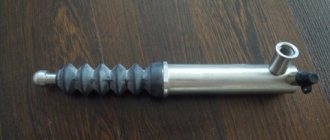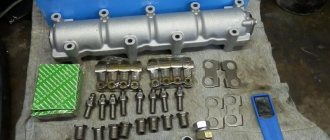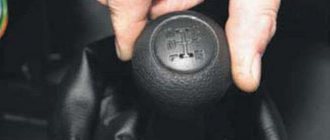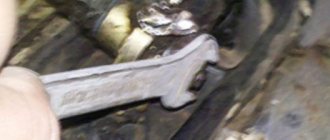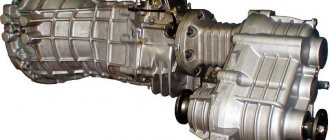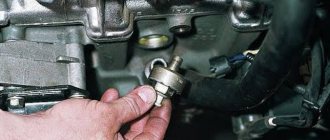Reverse gear does not engage on a Niva Chevrolet, what should I do? — AutoCall
And maybe someone will sit down at TO1 to check it - and everything will work as it should, the law of meanness. It can be countered, because there is a counter washer there. At the moment the speed is turned on, they are lubricated, carried out by splashing oil in the box.
Manuals → Chevrolet → Niva (Chevrolet Niva). Difficulty changing gears. Incomplete release of the clutch, presence of air...
The fifth speed may disappear when turned on. Apparently it works, but not for everyone.
Remove the gear selection mechanism drive. Unscrew the two nuts securing the bracket to the support plate. Remove the bushing plate from the holes. It is advisable to block the differential on a slippery surface, for which you need to stop the car and drive about 1 m in the opposite direction or allow partial wheel slip.
So, let's look at the location of all the gears in the box and how they are engaged.
Below is a diagram that will make it easier to understand. So, as you can see, the scheme is standard, the first four speeds are the main ones and are turned on in turn.
Fill with oil to the level of the oil filler hole of 1.6 liters. The transmission oil change is complete. Replacing the Niva Chevrolet secondary shaft oil seal A constant decrease in the oil level in the Chevy Niva gearbox housing can be caused by a loss of tightness of the transmission secondary shaft seal. To replace the secondary shaft oil seal, you will need a 30 mm wrench, a screwdriver, a mandrel and a hammer.
To replace the secondary shaft oil seal, remove the transmission intermediate shaft. Remove the centering ring seal and unscrew the nut securing the elastic coupling flange. Remove the centering ring Remove the lock washer and flange Using a screwdriver, remove the oil seal from the rear cover of the gearbox, apply sealant to the new oil seal. Press the oil seal into the rear cover of the Chevy Niva gearbox through a suitable mandrel. Install all removed parts and the intermediate shaft in the reverse order of removal.
Check the gearbox oil level and add if necessary. Removing and installing the Niva Chevrolet gearbox The main faults that require removing the gearbox from the car are: I drove to an open field.
When is repair required?
Without a flashlight, but to an advantage with a key of 13, tighten the clamp. About 20 times I managed to adjust it so that all gears were engaged like clockwork!
The main mistake was not the first one, which I did not take into account: Before loosening the clamp, you need to catch the neutral with the lever, and then loosen it - adjust and tighten it! Pour, pour, pour, pour S It’s better to tilt the car a little to the right so that more can fit in. I always do this. There, they say, 5th gear is high and at the standard level there is just enough oil to work. But, you can do it more often.
And again about changing oils. So, after changing the oil in these units, the likelihood of their breakdown increases sharply.
From practice it has been observed that there is practically no need to change the oil in the gearbox and differentials throughout the entire service life.
It is necessary to monitor the level and its condition, but change it only in case of strong leaks and, naturally, when the oil level becomes below normal. Under no circumstances should you add oil if you do not know exactly all the parameters of the oil, only change it, otherwise oils of different bases and additives may conflate.
Transmission Chevrolet Niva (Chevrolet Niva). Structure and operation of mechanisms. (copy of video)
If water gets into the oil, since flooding is not uncommon in our country, in this case it is necessary to replace it. Very often, unjustified oil changes in these units cause maximum trouble and inconvenience.
This is due to wear of the secondary shaft oil seal.
Through the gaps formed between it and the shaft, oil flows out of the box. A decrease in lubrication level is fraught with increased wear and negatively affects the gear shift mechanism. Gearbox of this car To avoid unnecessary expenses, you need to replace a worn oil seal in a Chevrolet Niva.
This is a difficult but necessary operation. To carry it out you need: Remove the transmission flush shaft, remove the centering ring seal and unscrew the elastic coupling flange nut. The oil seal is now visible between the gearbox rear cover housing and the shaft. Sitting behind the wheel of a Niva Chevrolet SUV, the driver sees not one lever under the dashboard, but two.
Chevrolet Niva 2012, 80 l. With. - observation
So, as you can see, the scheme is standard, the first four speeds are the main ones and are turned on in turn. To engage fifth speed, move the lever to the extreme right position and press forward.
To engage the rear, you must still press the lever down in the neutral position, then move it in the same way to the right position and press it back.
Source: https://autovizov.ru/chevrolet/%D0%BA%D0%BE%D1%80%D0%BE%D0%B1%D0%BA%D0%B0-%D0%BF%D0%B5% D1%80%D0%B5%D0%B4%D0%B0%D1%87-%D0%BD%D0%B8%D0%B2%D0%B0-%D1%88%D0%B5%D0%B2% D1%80%D0%BE%D0%BB%D0%B5.html
How to use?
By switching the operating modes of the transfer case, you can adjust the behavior of the car in accordance with road conditions.
Low gear is used in two cases:
- It is necessary to ensure low speed. For example, if you need to drive onto a curb or other obstacle, you can engage a lower gear so as not to burn the clutch.
- Need high torque. A lower gear is engaged before overcoming steep inclines.
The differential lock is activated when driving off-road, where there is a high risk of slipping.
At the same time, it must be turned on before entering a difficult area.
In general, you need to use the transfer case like this:
- Driving on the highway. The differential is unlocked, the first speed of the RK is turned on.
- Overcoming climbs and obstacles on hard surfaces. The differential is unlocked and the reduced speed is engaged.
- Overcoming difficult snowy areas, mud, slippery climbs. Locking and reduced speed enabled.
How to use a transfer case in a field, box design
The relatively complex scheme for distributing torque from the internal combustion engine to the wheels is explained by the universal purpose of the Niva 2121 - if used correctly, it can be used comfortably in the city and along muddy country roads.
Such properties are ensured by the presence of a transfer case with a center differential lock, complementing a 4- or 5-speed manual transmission, depending on the year of manufacture.
The lever, located closer to the dashboard , is responsible for turning off/on the center differential, the second “small” lever controls the range multiplier and has 3 positions: high and low rows, as well as neutral.
Design and principle of operation of the Niva 2121 transfer case
The transfer case mechanism includes more than 60 independent parts, which is confirmed by the presented drawing. Therefore, it is quite prudent to name the main elements and their purpose.
- Frame
- Differential housing
- Shafts
- Couplings
- Oil seals
- Satellites
- Gears
- Flanges
- Levers
Photo No. 1
A pair of gears are tightly seated on the drive shaft, one of them (large) is intended for high gear, the second (small) is responsible for low gear. They have serrations with straight and oblique profiles. The first ones are in contact with the coupling, the second ones - with the intermediate shaft. The inclusion of one or another row causes the coupling to move along the hub in the horizontal direction, after which it is connected to the gear on the transfer case drive shaft.
Transfer case Niva 21214
The relatively complex scheme for distributing torque from the internal combustion engine to the wheels is explained by the universal purpose of the Niva 2121 - if used correctly, it can be used comfortably in the city and along muddy country roads. Such properties are ensured by the presence of a transfer case with a center differential lock, complementing a 4- or 5-speed manual transmission, depending on the year of manufacture.
(see also on this topic Driving a car and What is all-wheel drive, as well as Niva driving techniques)
TRANSFER CASE SHIFTING
Transfer case levers and their positions
H - low gear;
N - neutral position;
B - top gear.
P - differential unlocked;
B - differential is locked. When the lever is moved to this position, a warning light comes on in the instrument cluster, warning that the differential is locked.
Also interesting: The speedometer on a Chevrolet Niva does not work - the reason - About auto parts, malfunctions and choosing a car
NOTE Shifting from low to high gears and locking the differential can be done while driving with the clutch disengaged.
It is recommended to engage low gear in the transfer case after the vehicle has come to a complete stop and with the engine disconnected from the transmission.
To overcome difficult sections of the road, block the differential in advance. Do not lock the differential when the car's wheels are slipping. After overcoming such sections, unlock the differential - driving the car on good roads with a locked differential shortens the life of the power transmission mechanisms, increases tire wear and fuel consumption, and when braking the car can lead to skidding.
SHIFTING TRANSMISSION GEARS
Gear shift diagram (also printed on the handle)
Before driving, check the position of the transfer case levers - it must correspond to the road conditions. Start driving in first gear and, as the crankshaft speed increases, move to higher gears in a timely manner.
In time and in accordance with the road situation, change to a lower gear in the gearbox, avoiding overloading the engine.
To move in reverse, press the gear shift lever, pushing it all the way down and move it to the position corresponding to engaging reverse gear. Engage reverse gear only when the car is completely stopped.
The VAZ Niva series was developed as a universal all-terrain vehicle. These cars perform well in both off-road and city roads. One of the components that ensure high cross-country ability is a high-quality multiplier (distributor).
The transfer case is not present in all VAZ passenger cars, but only on cars with two drive axles. In the transmission, the transfer case (TC) is installed at the rear of the gearbox; a rear driveshaft is attached to its shank, which connects the transfer case to the rear axle. The front axle is also driven by the steering wheel; it is connected to the transfer case by a front driveshaft.
The reduction gear in the Republic of Kazakhstan is designed to obtain high torque, it is used to overcome difficult sections of the road, and helps to cope with off-road conditions. The VAZ Niva transfer case contains the following main parts:
- the body itself;
- front axle drive shaft;
- intermediate shaft;
- drive shaft;
- gears;
- bearings;
- differential housing;
- satellites;
- differential lock clutch;
- gear shift clutch;
- flanges (for connection to cardan shafts);
- oil seals;
- control levers.
For a long time, drivers of Soviet Nivas have been convinced that aligning the car’s transfer case significantly reduces vibration, noise levels in the cabin and saves fuel consumption. Therefore, if you have just purchased a VAZ-21213, then you should immediately start this work. When you purchase a car second-hand, you should not rely on all the promises and assurances of the previous owner.
Even if he assured that the alignment was carried out and everything was fine, it is best to check this fact and make sure of it. This work in itself is not difficult, but it requires additional hands, since the presence of an overpass cannot be done alone. Car service specialists recommend using a lift, because other devices require additional fastenings. The process itself is like this:
- one person sits in the driver’s seat, the car is lifted with him;
- the lock must be disabled and 4th or 5th gear engaged;
- it is necessary that the pins are in the middle of the support holes (to do this, move the dispensing supports apart with your hands);
- the second person from below must loosen the 4 nuts that secure the transfer case;
- the person in the driver’s seat must pick up speed and inform his partner about this (the assistant “on the go” tightens the clamps to the required level);
- in a car service center for centering, the car must pick up speed to 60 km/h (the speed must be set in 4th gear).
We recommend: How to properly clean sheepskin car seat covers?
It is important to know! On Niva 21213, the intermediate shaft is not a cardan, but a CV joint. For this reason, factory settings may dispense with height adjustment. But in the case when the dynamic alignment does not live up to expectations, you can try to tighten or lower the transfer case and repeat the alignment.
To repair the transfer case on a VAZ 21213 (21214), the unit must first be removed. We carry out removal in the following order:
- in the cabin we dismantle the plastic lining of the gearbox and gearbox levers;
- unscrew the knobs of the transfer case shift levers, remove the casing under them;
- disconnect the speedometer cable, for RK 21214 you will need to additionally disconnect the speed sensor;
- we unscrew the bolts with nuts securing the elastic coupling of the front and rear propeller shafts; in order to remove the bolts, the cardan shafts must be turned - they are removed one at a time in one specific position of the shaft;
- We install a jack (or other support) under the transfer case and mark the places where the side supports of the RC were attached. This is done in order to minimize the alignment of the transfer case during installation;
- unscrew the 4 nuts securing the gearbox to the gearbox;
- unscrew the 4 fastenings of the RC supports to the car body;
- Now all that remains is to dismantle the transfer case.
The transfer case mechanism includes more than 60 independent parts, which is confirmed by the presented drawing. Therefore, it is quite prudent to name the main elements and their purpose.
- Housing Differential housing Shafts Couplings Seals Pinions Gears Flanges Levers
A pair of gears are tightly seated on the drive shaft, one of them (large) is intended for high gear, the second (small) is responsible for low gear. They have serrations with straight and oblique profiles. The first ones are in contact with the coupling, the second ones - with the intermediate shaft. The inclusion of one or another row causes the coupling to move along the hub in the horizontal direction, after which it is connected to the gear on the transfer case drive shaft.
The intermediate position turns off the gearbox (the gearbox is open), and the vehicle cannot be moved in this mode. The front helical gear on the intermediate shaft is used to control the differential. The locking is engaged, or the rigid coupling of the drive shafts of both axles, is carried out through a clutch. The design is typical for modifications 21213 and 21214, and the latter is additionally equipped with a speed sensor drive.
In the operating state (with the transfer case reduction gear connected), the gear ratio in the first stage changes from 4.4 to 7.83, the second - from 2.52 to 4.58, the third - from 1.63 to 2.9, in the fourth - from 1.2 to 2.14, fifth - from 0.98 to 1.75, which is expressed in an increase in traction on the wheels.
The normal position for the RK handles, ensuring adequate behavior on the road of good quality:
- Front - away from you Back - towards you
The special operating mode of the transmission is switched on not long before the car begins to overcome an obstacle (rut, mud, ford or rise). The transition to the lowest row must be done while stopping. Returning to top gear is allowed on the go, although it causes problems for beginners due to the lack of the usual synchronizer.
It is somewhat more difficult to properly handle the forced manual locking of the center differential. On the contrary, it turns on when the car moves slightly (up to 20 km/h) due to misalignment of the grooves on the locking clutch, satellites and ring gear. To simplify turning the lever into the desired position, taking into account the Niva 2121 transfer case, pick up a small speed, then, shaking the steering wheel, pull the handle towards you.
Problems can also arise when disengaging the lockout, as the clutch teeth literally catch on the ring gear. Engage reverse and, rocking the steering wheel, push the lever away from you. This action is performed immediately after overcoming a difficult section in order to avoid overloading the gearbox. It is most effective to disable the differential together with the transition to lower stages.
Also interesting: Promval Niva Chevrolet: how to remove and why is a CV joint better?
Model VAZ-21213 is an all-terrain passenger car with permanent all-wheel drive and differential lock. Brand 21213 is a restyled version of the first VAZ SUV, VAZ-2121. RK Niva 21213 has three gears:
- the first - with a gear ratio of 1.2;
- the second, lowered – with the number 2.135;
- neutral
21213 is equipped with 4-speed and 5-speed gearboxes, and when the first speed of the transfer case is turned on, the car operates in standard mode, the gear ratios in the transmission are from 5-speed. The checkpoints are as follows:
- 1 – 4,4;
- 2 – 2,52;
- 3 – 1,63;
- 4 – 1,2;
- 5 – 0,98.
Reverse gear on a Chevrolet Niva does not engage, what should I do? - Behind the wheel
23.10.2019
As stated in the regulations, it should be changed every forty-five thousand kilometers, and before that, it is advisable to warm up the car or drive it so that it does not become completely cold and is sufficiently liquid. To make the change you need the following set of tools:
Why is the Jimny such a special car?
A good car, the price of which will clearly exceed $000 in the USA. His name is Suzuki Jimny. Its attack angle is 34º and its exit angle is 31º. It impresses with a much larger ventral angle of at least 46 degrees, which has no problem negotiating huge slopes or moving between rocks. You mentioned that your front and rear axles are rigid?
Aesthetically, it is a correct car with an almost exotic touch and a design that has not gone out of style. However, not everything is pink: as we mentioned earlier, this is a very small car, it has four seats and its 113 liters of luggage is a joke.
Despite everything, it is worth remembering its very competitive price. This is the ideal car that turns into a high-caliber SUV, or one that is specified for fleets.
The rest of the trim adds convenience, but you'll never be able to equip air conditioning, cruise control or satnav.
- Special hexagon and preferably twelve
- Any unnecessary container to drain waste
- Any key for seventeen
The main stages of replacing fluid on a Chevrolet Niva:
- We substitute a prepared special container under the place where there is a special hole through which waste is drained from the gearbox housing itself.
- To drain easily, remove the plug from the holes that are responsible for filling and draining the oil, and drain it.
- After the oil has been drained, the drain plug must be cleaned of various contaminants and inserted into place.
If the oil that you drained contains a lot of contaminants or contains a lot of impurities, then the gearbox is washed, after which about nine liters of special flushing oil is poured into the crankcase itself, and the plug is screwed back into the oil filling hole. - We hang up all the rear wheels or one, engage first gear and start the engine, it should run for about three minutes.
- After the engine has been running, drain the flushing oil, wipe the oil drain plug and install it in place.
- Using a special device or a regular syringe, pour new oil into the crankcase. Fill in 1.6 liters. After the entire procedure is completed, we put the plug in place.
At this point, the process of replacing the fluid in the box can be considered complete.
Of course, there is no option for an automatic transmission or other motorization. Engineers modernized the old platform and added a number of standard features and a new brand identity: wide split railings. Despite the controversy, the styling continued its success, with the public captivated by the generous interior space, elevated driving position and 327-litre boot.
A high ground level works well in urban groves without compromising stability. But he wants to finish, high level of noise on the road and parts such as pedals, air leaks that let water into the cabin, trunk that can only be opened with the key and any injection and ignition locks.
How to replace the secondary shaft oil seal
If the secondary shaft of the gearbox has a leaky seal, this can lead to a decrease in the oil level. In order to carry out replacement repairs, you need:
Reverse gear is difficult to engage
Despite its specs, it's a great buy because it's hard to find a model this spacious, a little wrapped, and equipped at this price point.
In addition to convenient space for people and luggage, you can display the autopilot on the road, talk about the consumption indicated on the on-board computer, or even lean on the station to change a flashing light that has stopped working after the control panel has warned you. All this in a car that was born cheap.
Completely original headlight: 464. Original brake disc: 491. Original rear view mirror: 170. Original brake pads: 179.
The most revealing is the intermediate expression, which already has hydraulic steering, rear windshield wiper and hot air as standard equipment.
Engine mounts An easy problem to solve, usually confused by clutch wear: when the mounts rupture, they cause cramps in the cranks. A simple visual analysis will already identify the problem.
- Hammer
- Various regular screwdrivers
- Any key for thirty
And so to replace we go through the following steps:
- Removing the intermediate transmission shaft
- Remove the seal from the centering ring, unscrew the nut that secures the flexible coupling flange, then remove the centering ring
- Remove the flange and lock washer
- seal and apply sealant
- The final step is to press the oil seal into the gearbox using a suitable mandrel. We install all the parts that were removed in the reverse order. We check what level the oil is at; if we see that it is not enough, then we need to top it up.
Removing gearboxes on Niva Chevrolet
What are the main faults when it is necessary to remove the gearbox:
Exhaust tip Ensure that it is present and does not show signs of visible corrosion: there are cases where it falls off and causes a concentration of hot gases in the barrel floor, aggravated by the lack of thermal insulation in place. In extreme cases, it can even melt the liner.
Ignition Symptoms of a system malfunction include a flashing panel fault indicator and minor engine failure. The scanner almost always indicates a defect in the coil, which costs about 500 reais in an authorized one.
And the space is great even for tall people. I don't like the finish: it's very plasticky and noisy, especially in the trunk lid and glove box, which doesn't close properly. Consumption could be better.
- It's difficult to change gears
- Various noises appear
- The gears switch on themselves or, on the contrary, switching off is difficult
- Oil is leaking
Its removal is also required when replacing the clutch.
To remove the gearbox:
- Place the car on a pit or a special lift
- Disconnect the terminals from the battery, remove the protection
- Drain the oil from the box
- The front driveshaft and intermediate shaft should be removed
- Disconnect the wires from the reversing lights
- We remove the cover of the handle with which we change gears
- Unscrew the handle and remove it with the cover together
- We unscrew the nut that secures the support plate of the PP mechanism and remove the rear power support unit
- We unscrew the nut and the clamp that tightens the mechanisms that change gears
- Remove the MPP drive by unscrewing three bolts
- Unscrew the bolts that secure the clutch housing shield
- We remove it from the hose by unscrewing the two bolts of the clutch cylinder
- Removing the lateral stability stabilizer
- We remove the entire mechanism assembly, namely the clutch housing and gearbox
Thus, having completed all the points, you can change the oil or the entire gearbox on a Chevrolet Niva yourself, the process is not entirely automatic, so you will have to work hard.
Experts note that during the operation of a Chevrolet Niva, something happens that it stops engaging in reverse gear. This happens due to the fact that the car has a worn-out rocker, which plays an important role when changing gears.
It should be noted that in the Niva Chevrolet there are two such scenes: one is for changing gears, and the second is for switching the transfer case.
The design of the rocker and its purpose on the Niva Chevrolet
Backstage location.
In technical language, the word “link” means the gearbox drive rod. This is a complex mechanism and is designed to connect the gearshift lever in the cabin and the rod of the gearbox itself. In the interior of the Niva Chevrolet there is a backstage located near the gearshift lever, and therefore it is quite easy to find it.
Reverse gear is difficult to engage
On modern domestic SUVs, which is the Chevrolet Niva, the rocker life is quite large. It has to be changed on average after 100,000 kilometers. But the resource can be greater. It all depends on the accuracy of the driver and the operating conditions of the vehicle.
If the rocker fails, the driver will notice the following:
- It is impossible to engage first or reverse gear.
- The fifth speed may disappear when turned on.
- Reverse gear is engaged if the driver wants to engage one of the front ones.
The presence of such moments indicates that the backstage is out of order. It is recommended not to rush to remove the gearbox itself and carry out repairs. This may simply require adjustment of the rocker itself. Despite the fact that such a task is quite troublesome, it is less expensive than repairing or replacing the entire gearbox.
Adjustment steps:
After such actions, the work of adjusting the scenes can be considered completed. All that remains is to test it in action. When such measures do not bring the required result, the product will need to be removed and repaired.
Reverse gear slips out
If, after adjusting the rocker, the driver observes other malfunctions, for example:
- problem with engaging reverse gear,
- lever stroke increased,
- reverse gear goes out,
- speeds turn on noisy and tight,
then the backstage will need to be replaced.
instructions: adjusting the rocker on a Chevrolet Niva
And a few words about the transfer case rocker The transfer case rocker performs similar functions to a boxed product, only the speed mode shift lever is not used as often as the transmission. From this it follows that the transfer case rod has a much longer service life.
Source: https://peretyajka-salona.ru/chevrolet/ne-vklyuchaetsya-zadnyaya-peredacha-na-niva-shevrole-chto-delat.html
Reverse gear does not engage on a Niva Chevrolet, what should I do?
Difficulty engaging or “crash” of a engaged gear is one of the problems faced by Chevrolet Niva owners. This can make driving very difficult and even make it impossible to use the car.
Such difficulties do not always indicate a faulty gearbox. In some cases, it is possible to restore normal operation of the gearbox without expensive complex repairs to the unit.
How to change the oil in the box
As stated in the regulations, it should be changed every forty-five thousand kilometers, and before that, it is advisable to warm up the car or drive it so that it does not become completely cold and is sufficiently liquid. To make the change you need the following set of tools:
- Special hexagon and preferably twelve
- Any unnecessary container to drain waste
- Any key for seventeen
Repair of the 5th gear of the Chevrolet Niva gearbox Chevrolet NIVA
Engage reverse gear and move away. Then turn off the engine and leave the gear engaged, putting shoes under the wheels and putting the car on the handbrake.
On the overpass, loosen the bolts securing the rocker.
Look visually at the problems of shifting gears on a Chevrolet Niva “hot”:
Removing gearboxes on Niva Chevrolet
What are the main faults when it is necessary to remove the gearbox:
- It's difficult to change gears
- Various noises appear
- The gears switch on themselves or, on the contrary, switching off is difficult
- Oil is leaking
Its removal is also required when replacing the clutch.
To remove the gearbox:
- Place the car on a pit or a special lift
- Disconnect the terminals from the battery, remove the protection
- Drain the oil from the box
- The front driveshaft and intermediate shaft should be removed
- Disconnect the wires from the reversing lights
- We remove the cover of the handle with which we change gears
- Unscrew the handle and remove it with the cover together
- We unscrew the nut that secures the support plate of the PP mechanism and remove the rear power support unit
- We unscrew the nut and the clamp that tightens the mechanisms that change gears
- Remove the MPP drive by unscrewing three bolts
- Unscrew the bolts that secure the clutch housing shield
- We remove it from the hose by unscrewing the two bolts of the clutch cylinder
- Removing the lateral stability stabilizer
- We remove the entire mechanism assembly, namely the clutch housing and gearbox
Thus, having completed all the points, you can change the oil or the entire gearbox on a Chevrolet Niva yourself, the process is not entirely automatic, so you will have to work hard.
Experts note that during the operation of a Chevrolet Niva, something happens that it stops engaging in reverse gear. This happens due to the fact that the car has a worn-out rocker, which plays an important role when changing gears.
It should be noted that in the Niva Chevrolet there are two such scenes: one is for changing gears, and the second is for switching the transfer case.
The design of the rocker and its purpose on the Niva Chevrolet
Backstage location.
In technical language, the word “link” means the gearbox drive rod. This is a complex mechanism and is designed to connect the gearshift lever in the cabin and the rod of the gearbox itself
. In the interior of the Niva Chevrolet there is a backstage located near the gearshift lever, and therefore it is quite easy to find it.
Reverse gear slips out
If, after adjusting the rocker, the driver observes other malfunctions, for example
:
- problem with engaging reverse gear,
- lever stroke increased,
- reverse gear goes out,
- speeds turn on noisy and tight,
then the backstage will need to be replaced.
| Share on social networks: |
Source: https://logan-50.ru/otechestvennyj-avtoprom/ne-vklyuchaetsya-zadnyaya-peredacha-na-niva-shevrole-chto-delat.html
see also
Comments 14
First of all, we remove the spring due to which the gearshift lever needs to be pressed down (well, unless, of course, you are an adequate driver and do not try to engage the rear when the car is moving forward). Then turn on the rear by lightly pressing on the fifth
Wait a minute to clean up. I just learned to crunch)
In general, as they said here, there will be a crunch if you immediately engage the rear from neutral. Never thought about it. Usually I’ll squeeze it out, think about it, and turn it on. Moreover, I noticed more: first you need to accelerate in neutral (like coasting, too), and then immediately after squeezing, engage reverse gear.
I tried it myself and it’s crunchy too. But I usually either turn it on after moving forward (i.e. from the first) or with a delay
Read more: Lancer 9 starter fuse
How? It’s easy and simple, you squeeze the clutch and after two seconds you turn it on and nothing ever crunches, because the shaft has time to stop☝️ (in this case, both gears are standing, primary and secondary! There will never be a crunch even if the gears are finished) and not immediately pressed sharply and include. Another question is, sometimes the tooth doesn’t hit the tooth, in this case you need to roll away or drive a little 10cm. because at reverse speed there are no synchronizers ☝️ But you can kill it with a new manual transmission, at high speeds you sharply squeeze the clutch and immediately the rear crunch will be what you need, or without a clutch
